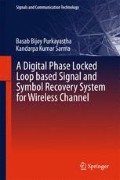Abstract
Electrical communication transmitter and receiver techniques strive toward obtaining reliable communication at low cost, with maximum utilization of the channel resources. The information transmitted by the source is received by the destination via a physical medium called a channel. This physical medium, which may be wired or wireless, introduces distortion, noise, and interference in the transmitted information bearing signal. To counteract these effects is one of the requirements while designing a transmitter and receiver end technique. The other requirements are power and bandwidth efficiency at low implementation complexity.
Access this chapter
Tax calculation will be finalised at checkout
Purchases are for personal use only
References
Nakagami M (1960) The m-distribution—a general formula of intensity distribution of rapid fading. In: Hoffman WC (ed) Statistical methods in radio wave propagation. Pergamon, New York, pp 3–36
Jakes WC (1974) Microwave mobile communications. Wiley, re-issued by IEEE Press
Clarke RH (1968) A statistical theory of mobile-radio propagation. Bell Syst Technol 47(6):957–1000
Gradshteyn IS, Ryzbik IM (2000) Tables of integrals, series and products, 6th edn. Academic Press, San Diego
Pop MF, Beaulieu NC (2001) Limitations of sum-of-sinusoids fading channel simulators. IEEE Trans Commun 49:699–708
Pop MF, Beaulieu NC (2002) Design of wide-sense stationary sum of sinusoids fading channel simulators, In: Proceedings of the IEEE ICC, pp 709–716
Xiao C, Zheng YR, Beaulieu NC (2006) Novel sum-of-sinusoids simulation models for Rayleigh and Rician fading channels. IEEE Trans Wirel Commun 5(12):3667–3679
Proakis JG (2001) Digital communications, 4th edn. McGraw-Hill, New York
Wu T-M, Tzeng S-Y (2003) Sum-of-sinusoids based simulator for Nakagami-m fading channels. In: Vehicular technology conference 2003, VTC 2003-Fall IEEE 58th, vol 1, 6–9 October 2003, pp 158–162
Zhang QT (2004) A decomposition technique for efficient generation of correlated Nakagami fading channels. IEEE J Sel Areas Commun 18(11):2385–2392
Further Reading
Haykin S (2008) Communication systems, 4th edn. Wiley, Hoboken
Proakis JG, Salehi M (2007) Digital communications, 5th edn. Tata McGraw-Hill, New Delhi
Lapidoth A (2009) A foundation in digital communications. Cambridge University Press, Cambridge
Couch LW (2000) Digital and analog communication systems, 6th edn. Prentice-Hall Inc, New Jersey
Rappaport TS (2002) Wireless communications: principles and practice, 2nd edn. Pearson Education Inc, Singapore
Haykin S, Moher M (2002) Modern wireless communications. Pearson Education Inc, Singapore
Mark JW, Zhuang W (2005) Wireless communications and networking. PHI, New Delhi
Feher K (1995) Wireless digital communications: modulation and spread spectrum applications. Prentice Hall, Upper Saddle River
Blake R (2004) Wireless communications technology. Thomson Asia Pvt Ltd, Delmar
Agarwal DP, Zeng Q-A (2007) Introduction to wireless and mobile systems. Thomson Learning, Nelson
Author information
Authors and Affiliations
Corresponding author
Rights and permissions
Copyright information
© 2015 Springer India
About this chapter
Cite this chapter
Purkayastha, B.B., Sarma, K.K. (2015). Modulation Techniques and Signal Processing. In: A Digital Phase Locked Loop based Signal and Symbol Recovery System for Wireless Channel. Signals and Communication Technology. Springer, New Delhi. https://doi.org/10.1007/978-81-322-2041-1_3
Download citation
DOI: https://doi.org/10.1007/978-81-322-2041-1_3
Published:
Publisher Name: Springer, New Delhi
Print ISBN: 978-81-322-2040-4
Online ISBN: 978-81-322-2041-1
eBook Packages: EngineeringEngineering (R0)

